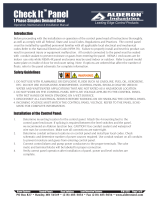
2
General
Information
This manual contains important
information for the safe use of
this product. Read this manual
completely before using this
product and refer to it often
for continued safe product use.
Do not throw away or lose
this manual. Reasonable care
and safe methods should be
practiced. Check local codes and
requirements before installation.
Unpacking Panel:
When unpacking unit, check
for concealed damage. Claims
for damage must be made at
the receiving end through the
delivery carrier. Damage cannot
be processed from the factory.
CALIFORNIA PROPOSITION
65 WARNING:
This product and
related accessories contain
chemicals known to the
State of California to cause
cancer, birth defects or other
reproductive harm.
Power Supply
WARNING: Do not attempt to
wire this control box unless you
have a good working knowledge
of electricity and are familiar
with the state and local codes. If
you are in doubt about anything,
contact a qualified electrician.
Do not attempt to operate this
unit on any other voltage or
power distribution other than for
which it was originally designed
(check nameplate). Failure to
comply with this will result in
the immediate cancellation of all
warranties and claims.
It is advisable to put the panel
on its own circuit using a circuit
breaker adequately sized to
protect the pump(s). Check state
and local codes for the correct
wire size and circuit protection
to use. The wire should be sized
large enough to handle the full
load current of the pump(s) you
are operating, and any voltage
drop that might occur due to long
service runs.
Run power supply lines to the
control box and secure. Select
a convenient location on the
bottom to enter the box with the
power supply. Cut a hole with
a chassis punch. Avoid getting
metal chips in the components
while cutting hole. After the hole
is cut, any metal particles must
be removed from the box. Failure
to do so may result in premature
component failure.
Connect incoming power to the
terminal blocks labeled L1, L2,
L3 and all necessary ground
wires to the ground lug at the
bottom of the box. The ground
lug should be fastened to a good
driven earth ground by one of
the methods described in the
National Electric Code. NEC
does not permit using ground
as a current carrying conductor,
therefore a neutral must be
provided for 115 volt 1-phase,
208 volt 1-phase, 230 volt
1-phase or 208 volt 3-phase
systems.
WARNING: Before handling
these pumps and controls, always
disconnect the power first. Do
not smoke or use sparkable
electrical devices or flames in
a septic (gaseous) or possible
septic sump.
Electrical Connections:
The contractor must conform
to the latest requirements of
the National Electrical Code.
All conduit and cables shall be
in accordance with NEC Code
NFPA #70. To maintain UL and
CSA ENCL rating, use the same
type UL and CSA weatherproof
conduit hubs when connecting
to this enclosure. Prior to
conducting any installation,
repair or service with regard to
the control panel, refer to the
schematic appropriate for that
panel. The schematic will provide
guidance with regard to the
terminal block connections.
CAUTION: A nonmetallic
enclosure does not provide
grounding conduit connections.
Use grounding bushing and
jumper wires.
Make the Following Electrical
Connections:
a. Connect the pump leads to
the control panel. If pump is
single-phase and the panel
has start capacitor, start
relay and run capacitor, it is
critical that the pump leads
be connected properly. The
White, Black and Red pump
leads must be connected to
the appropriate terminals
as directed by the panel
schematic and the label
on the back panel below
the terminals.
b. Connect the pump heat sensor
and seal failure leads (if
available on the pump) to the
appropriate terminal blocks
in the control panel.
c. Connect all the float control
leads or 4-20mA leads to the
appropriate panel terminals.
Contractor must be very
careful in locating the floats
at the proper elevations. The
maximum distance from the
control panel to the floats
is the lesser of l00 feet,
or the maximum distance
recommended for the pump.
d. Before connecting power to
the control panel, make sure
all control switches (e.g.
H-O-A switch) and protective
devices (e.g. breakers) are








